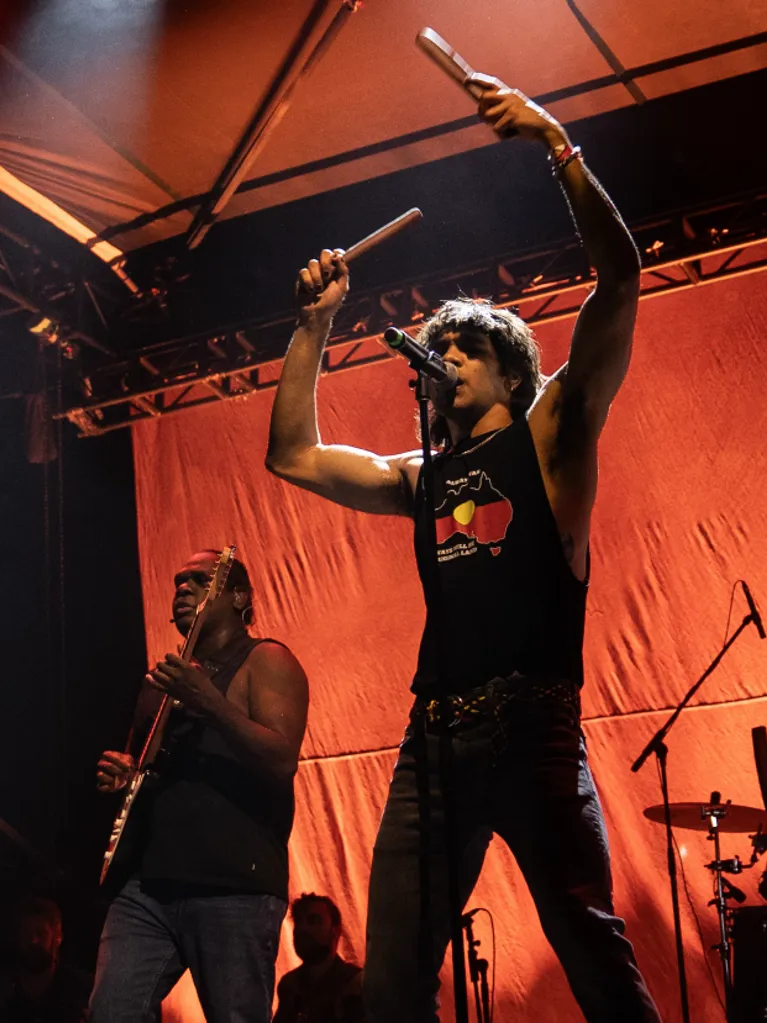No reception. Red dirt for days. The kind of skies that rearrange your idea of what a sunset should look like.
That’s where you’d have found eighteen JMC Academy students earlier this month. Not in a studio or classroom, but camping on Country in the Northern Territory, working behind the scenes at Barunga Festival.
For the uninitiated, Barunga is more than a festival. It’s a living, breathing gathering of First Nations culture, held on Jawoyn Country near Katherine. It’s part ceremony, part sports carnival, part music festival, part masterclass in truth-telling… and it’s been going strong for almost four decades.
For the fourth time in five years, students from JMC’s Film & TV, Audio and Entertainment Business Management faculties across the country made the journey north to get their hands dirty (literally!) as part of a once-in-a-lifetime opportunity to support the festival through content capture, live sound production, and event operations.
"It’s a celebration of community, with visitors welcome not as tourists, but as students of Indigenous culture."
“It’s a community-led festival that brings together families, artists, elders, students, and visitors from all over Australia and even internationally,” explains Entertainment Business student Georgie Gamble. “There are stages, traditional dancing, local sports games, food stalls, cultural workshops, even spear-throwing competitions. Every aspect is built on a foundation of First Nations knowledge and pride.”
For JMC’s student crew (plus a few of our amazing educators!), this was no drop-in gig. They camped on site and earned their keep alongside seasoned industry professionals, mixing live sound for performers, capturing film and photo content - including switching vision on the giant screen for performers such as Kootsie Don, East Journey, the Red Flag Dancers, Thelma Plum and the musical theatre experience Big Name, No Blankets (Warumpi Band)... and rolling up sleeves behind the scenes in every kind of event role imaginable.
“The most unexpected thing at Barunga would definitely be the working for E3 Productions for the live broadcast,” said film student Harry Patton. “One moment I was live-switching and the next thing I was in front of the camera doing camera operations. Being able to adapt in that scenario gives you that good experience and grounding when you are in a high tense situation and you learn how to deal with that and manage that.”
But the technical work was only part of it. The real lessons were less about gear and logistics and more about cultural grounding.
“This festival is pretty unique compared to others I’ve attended or worked at,” reflects Georgie. “No VIP wristbands or sponsorships from big booze companies. It’s not built for social media or photo opportunities. It’s built on 40,000 years of storytelling and connection. It’s a celebration of community, with visitors welcome not as tourists, but as students of Indigenous culture.”
And that student mindset was key in so many dimensions. From elders’ yarns to dance ceremonies and late-night fireside jams, every moment was a chance to learn, not just about production or event logistics, but about listening. About presence. About paying attention to the stories that are already being told, and understanding that sometimes the most powerful thing you can do is not press record, but stand still.
“As an international student travelling with people to a new place was an extraordinary experience,” shared film student Julia Schrepfer. “I think when you live in another country you should learn about the culture.”
“Being there reminded me that some of the most moving forms of storytelling don’t have to come with programmed lighting sequences or abide by strict set times,” Georgie continues. “It can live in dance, in language, in the way that people gather. At Barunga, storytelling is the entertainment. And it’s not just to perform for others; it’s for survival. It’s how culture is preserved, how knowledge is passed on, and how communities stay connected across generations.”
The trip wasn’t all work. Students also had the chance to explore the Top End — from cooling off in the plunge pools at Litchfield, exploring the magical depths of Cutta Cutta Caves, to cruising the ancient gorge systems of Nitmiluk (Katherine Gorge), to simply sitting still in the silence of wide-open space. For many, it was their first time on Country. For all, it was unforgettable.
“Walking on land that has had people and culture for the past 60,000 years was another worldly experience,” added film student Uther Reed.
And while a few nights under canvas might’ve felt a long way from their city campuses, our students returned with something no studio session or lecture could ever replicate: real-world experience, deep cultural exposure, and a rare glimpse at what production work looks like when the stakes are sacred, not staged.
Film student Uther reflected "This was my first time really working with the EBM department and the (production) company that was running the show. It really gave a lot of perspective about the scale of those operations... and how I can in my film work, better to support the Entertainment Management department."
Barunga isn’t meant as a protest or a political statement, Georgie reminds us. “It’s a celebration. But that celebration shows to people that this land holds stories older than any other existing culture. These stories are still being told, not for our entertainment, but told on their own terms.”
At JMC, we talk a lot about the power of creative careers and through this experience, our students have lived it. They came back with more than just a few hours of practical shift work— they came back with new eyes, new questions, and a deeper understanding of why we tell stories, why we are creatives, in the first place.
Because out there, where the red dirt meets the dreaming, stories don’t just entertain. They carry. They teach. They protect. And if we’re lucky, they welcome us in.
Words by Clare Neal
Cover image: Harry Paton



